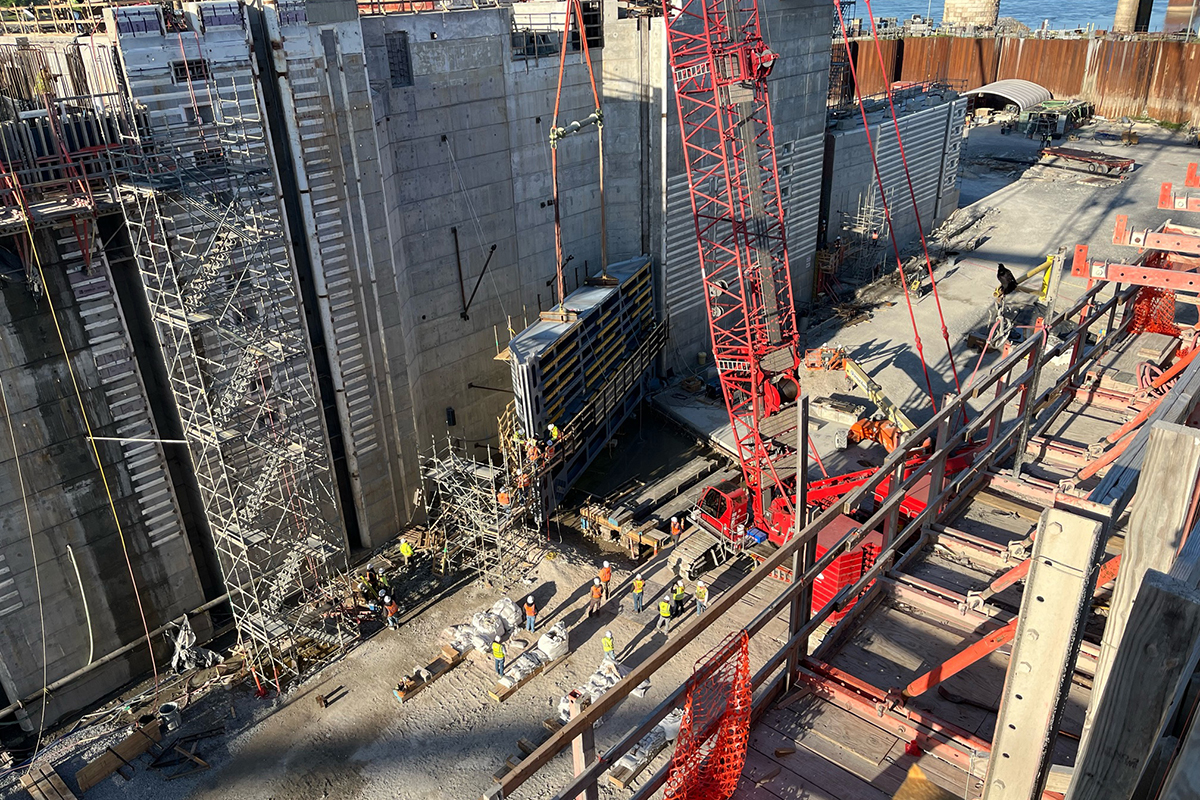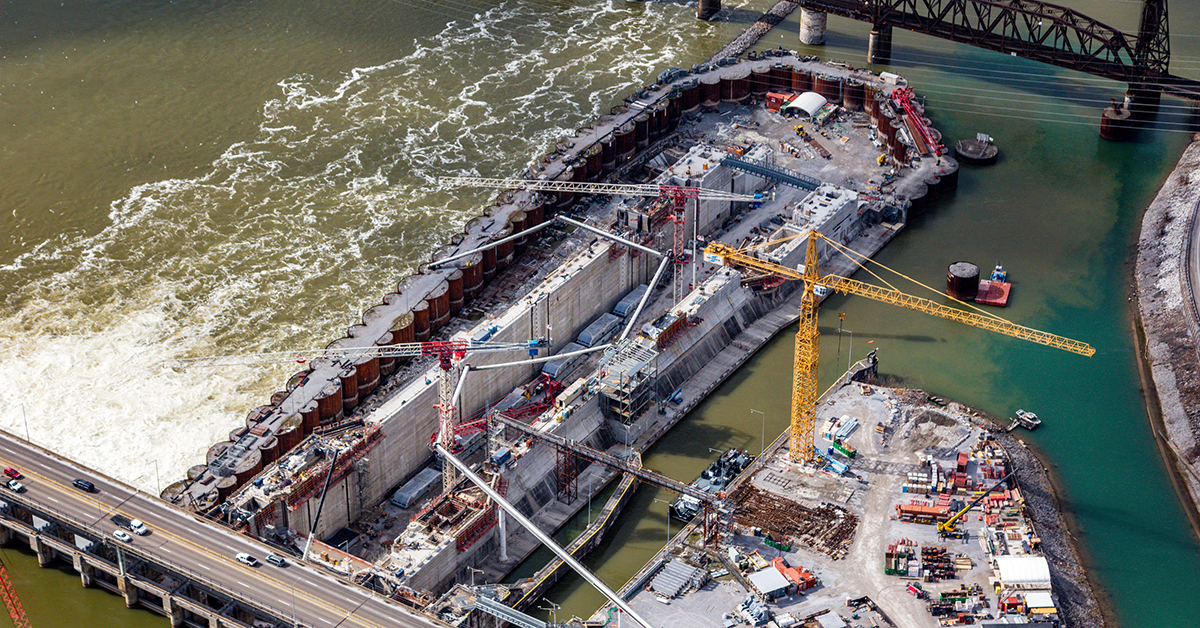Construction of a new, 600- by 110-foot lock at Chickamauga Lock and Dam on the Tennessee River has reached two major milestones, with crews beginning to erect the new lock’s massive miter gates and also taking delivery of the second nose pier, a towering concrete structure the Nashville Engineer District said is essential to guiding vessels safely into the new lock chamber.
The lock is located at Tennessee River Mile 471.0, 6.9 river miles above Chattanooga, Tenn.
Miter Gate Pieces Arrive
Shimmick Construction, contractor for the lock contract, had 14 miter gate pieces delivered into the cofferdam in December, said Joseph Cotton, project manager for the Chickamauga Lock Replacement Project. Ten are for the downstream side of the lock and four for the upstream side. Installation began the first week in April, with a large-capacity crane used to lift and position the first piece into its final location in the lock chamber after an inspection determined proof of concept. A second piece is now in place.
Built by certified fabricators, the pieces are a specific type of hydraulic steel structure designed to withstand immense water pressure while regulating water levels. They will be stacked and welded together.
“Seeing these massive gate pieces lifted and assembled into place is truly a testament to the expertise and coordination required in mega infrastructure projects,” said Kyle Phillips, technical lead for the district. “This process marks a significant achievement in the progress of the Chickamauga Lock Replacement Project and brings us closer to project operational status.”
Miter gate assembly is expected to be completed by the end of the year.
“It’s really looking like a lock now,” Cotton said. “We’re over 95 percent complete with concrete placements. Seeing the gates going up allows us to move forward with our planning for the electrical and mechanical pieces that will come in afterwards.”
The lock contract is expected to be complete by the end of 2026.
Second Nose Pier Delivered
Separately, contractor CJ Mahan Construction Company has taken delivery of the second nose pier, part of the upstream approach walls contract. Standing 29.5 feet tall, the pier was transported via barge from Iuka, Miss., passing through Wilson, Wheeler, Guntersville and Nickajack locks.
“A highlight of this delivery was the strong coordination between our team, the contractor and the barge industry,” said Bob Winters, project manager for the Nashville District. “Prioritizing the nose pier’s passage through Wilson Lock was critical to keeping the project on schedule and reflects our commitment to efficient, well-executed construction.”
The delivery of the second nose pier means all the steel shells making up the approach walls are now in position, Cotton said. Concrete will now be placed to complete the piers to the final elevation.
The next major phase will involve delivery of the approach wall beams that fit between the piers. Cotton described them as similar to “giant Lincoln logs” that must be placed precisely. The beams measure up to 120 feet long and weigh as much as 450 tons.
For now, the beams are being stored at Watts Bar Lock and Dam. Deliveries by barge to Chickamauga are expected to take place in July and August, with installation to be completed in August and September, Cotton said.
Approach walls help to guide vessels safely into the lock chamber. Much like a funnel, they direct barges away from turbulent waters that can flow over the dam’s spillway during high-water events.
The Nashville Engineer District is on track to complete all work related to the upstream approach walls contract by this fall.

Final Contract Out For Bid
The final contract for the project, which includes the downstream approach walls and decommissioning, was let for bids on February 4, with a deadline set of July 8. Cotton said the district expects to have the contract awarded by the end of the year.
“We’re excited to get this final contract awarded,” he said, adding that the award would be made after taking into consideration not only the cost of the proposal but also its feasibility, duration of construction and safety elements.
The Corps conducted two pre-proposal site visits with prime contractors and subcontractors to assist them in putting together proposals.
Funding received in Fiscal Year 2024 is sufficient to award the base contract, Cotton said. The Corps did not request funding in Fiscal Year 2025 and is awaiting proposals from contractors before determining if requests for 2026 and 2027 are appropriate, he said.
Cotton said there could be challenges with having crews for three different contracts on the project site at the same time, but he credits an extraordinary amount of proactive communication, along with attention to detail by the design staff and construction teams, as making it possible. He pointed out that crews have worked roughly 1.5 million man-hours without a single lost time incident on site. The average is about 1.8 incidents per 200,000 man hours.
The existing Chickamauga Lock, completed in 1940, accommodates one standard-sized barge at a time. It will not be decommissioned until the Corps is confident the new lock is operating reliably, Cotton said. Closures of no more than 12 hours, and possibly less, will take place during the transition from the old lock to the new one as additional approach wall beams are lifted into place.
“That’s 450 tons of concrete we’re going to have up in the air,” he explained as a reason for caution.
Outages related to the downstream approach wall beams are not expected to occur until 2027 and 2028. Following each closure, the Corps will clear the queue before closing it to lift another beam.
“We know we can continue to work through those challenges and do it in a safe way and get everyone home every night,” Cotton said.
Project Importance
The Chickamauga Lock Replacement Project was Congressionally authorized in 2003 to counteract an alkali aggregate reaction that causes concrete growth in the old lock. Road relocations began in 2006, with cofferdam placement and excavation continuing through 2012 before funding difficulties put the project on hold. With the advent of efficient funding beginning in 2018, the project has made major steps forward, Cotton said. The Corps now expects the new lock to be operational in 2028 and the project to close out in 2031.
Chickamauga Lock supports the movement of about 1.5 million tons of cargo annually. Cargo movements have been fairly consistent over the years, Cotton said, with some potential to increase barge transit, including the upstream movement of salt. Additionally, the Tennessee Valley Authority (TVA) has two nuclear power plants that rely on Chickamauga Lake for cooling water. Transportation of generators, turbines and transformers is much more efficient by barge.
Chickamauga’s continued operation also provides transportation resiliency and is increasingly important given the pace of construction in nearby Chattanooga, Tenn., as well as in Nashville, to the west, Cotton said. With no new pipelines to those population centers, more and more gasoline is also moving by barge, he said.
Additionally, Chickamauga Lock is the No. 2 lock for recreational vessels on the inland waterways system, behind only the Chicago Harbor Lock, Cotton said.
The new lock is expected to reduce transit times for commercial vessels by 80 percent, according to information provided by the Nashville District. Chickamauga Lock also connects the waterway system, with two navigation locks upstream on the Tennessee River and one on the Clinch River.
“The Chickamauga Lock is a vital link in our nation’s inland waterway system, and this project will ensure its continued reliability for decades to come,” Winters said. “The economic benefits will be felt throughout the region and beyond.”




